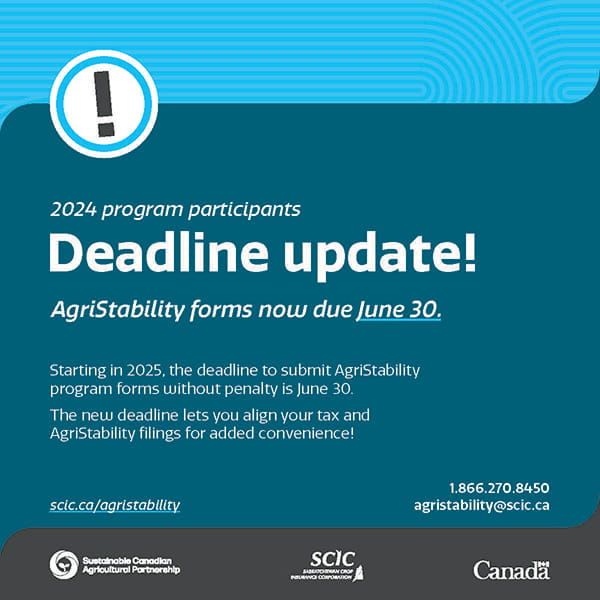Every day, you face a variety of challenges and risks to keep your operation running. We know timely on-farm decisions are your first and best line of defense against threats. When the factors beyond your control cause financial instability for your farm, the Saskatchewan Crop Insurance Corporation (SCIC) is here to help. The AgriStability Program is designed to step in and support you when you need it most, help bridge the gap on your farm and keep your operation moving forward.
Are you worried about any of the following risks:
- Production loss
- Increased costs
- Income loss
- Market volatility
Many risks can impact the success of a farm operation, but not all risks are the same. Some risks may impact one aspect of the business, while others may affect multiple areas. AgriStability operates under a model which considers the combination of risks and their impact on the overall profitability of the farm.
How AgriStability Works for Grain Producers
In addition to protecting against production loss and input cost increases, AgriStability also safeguards against risks related to storage and market declines. Have you experienced any of the following?
- Downgrading of grain:
- Spoiled grain from heating in the bin
- Insect and/or wildlife damage
- Temporary field storage
These are just some of the circumstances covered by AgriStability, through the whole-farm approach, providing risk protection even after harvest.
How AgriStability Works for Livestock Producers
When the bottom line of a livestock operation is threatened, AgriStability responds just as it does for grain and oilseed operations. Consider the revenue and expense portion of your operation – have you experienced any of the following?
- Feed shortages
- Additional veterinary expenses
- The need to transport animals elsewhere for feeding
- Herd reductions due to disease outbreaks or other health issues
The additional expense to manage these situations are allowable, under the AgriStability Program. When the costs accumulate and lead to a reduced margin, significantly impacting your farm’s profitability, AgriStability is there to provide support.
How AgriStability Works for Mixed Operations
AgriStability is a whole farm income program that considers the revenue and expenses across all aspects of the operation. This helps determine whether a farm can access a benefit. Even if your farm reduces risks by running multiple lines of business, AgriStability may still provide a benefit. When mixed farms generate benefits from AgriStability, it usually means a portion of their business has experienced some sort of hardship. The impact of this hardship on the farm’s margin is significant enough to generate benefits.
Personalized Protection for Every Farm
At SCIC we understand no two farms are the same. While there may be similarities in land bases or crops grown, you make personalized decisions that are best for you and your farm. Some of these decisions include:
- Nutrient management
- Timing of calving
- Feed programs
- Crop varieties
The individualized nature of AgriStability allows the program to respond to risks on your farm, ensuring personalized support rather than a one size fits all approach.
Deadline Changes
The deadline to submit 2024 AgriStability Program forms, without penalty, is now June 30, 2025. Applications received after the June 30 deadline are subject to a $500 per month penalty. Applications must be received by September 30, 2025. This change aligns AgriStability form submission with your tax filing. Submitting earlier means your file can be processed sooner, potentially leading to quicker payments.
It’s Easy to Enrol
Enrolling in AgriStability is as simple as calling the SCIC AgriStability Call Centre at 1-866-270-8450 and requesting a new participant package. The deadline to enrol in the 2025 AgriStability Program Year is April 30, 2025.
To learn more, visit SCIC's AgriStability webpage.

